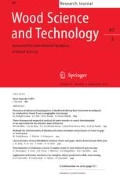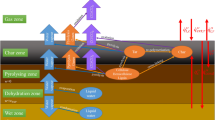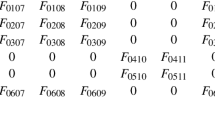Summary
The woody cell wall starts ontogenetically as an isotropic gel termed matrix which is later reinforced by elementary fibrils of cellulose and finally encrusted with lignin. The parallel texture of the fibrils induces the striking anisotropy of the wall. The reinforcing effect of the fibrils depends on the square of their length, their friction coefficient towards the matrix and the shear modulus (rigidity) of the matrix. Since the diameter of the reinforcing fibrils is not essential, but as their number is decisive, it makes sense that the cellulose fibres are dispersed down to the tiny elementary fibrils of only 35 Å diameter!
Based on the “reinforced matrix” concept, the irregular longitudinal shrinkage of wood samples depending on the helical angle of their tracheid ultratexture can be explained, but for the pronounced shrinkage anisotropy perpendicular to the wood axis the amount of cell wall substances liable to considerable hydration in radial and tangential walls must be taken into consideration.
Zusammenfassung
Die verholzte Zellwand besteht bei der Zellteilung ursprünglich aus einem isotropen Gel, der Matrix; später wird diese plastische Masse durch Elementarfibrillen aus Cellulose verstärkt und schließlich mit Lignin inkrustiert. Die Paralleltextur der Fibrillen verursacht die auffallende Anisotropie der Zellwand. Die Wandverstärkung durch die Fibrillen ist eine Funktion des Quadrates ihrer Länge, ihrer Reibungszahl mit Bezug auf die Matrix und des Schubmoduls (Steifheit) der Matrix. Da der Durchmesser der verstärkenden Fibrillen eine untergeordnete, die Zahl dieser Elemente dagegen eine entscheidende Rolle spielt, scheint es sinnvoll, daß die Fasercellulose in der Form von Elementarfibrillen bis zu einem Dispersionsgrad von 35 Å aufgeteilt ist!
Auf Grund der Theorie der “armierten Matrix” kann das unregelmäßige Längsschwindmaß von Holzproben in Abhängigkeit vom Steigungswinkel der Schraubentextur ihrer Tracheiden erklärt werden. Andererseits müssen für das Verständnis der ausgesprochenen Schwindungsanisotropie auf dem Holzquerschnitt die verschiedenen Mengen stark quellbarer Membransubstanzen in den Radial-und Tangentialwänden in Betracht gezogen werden.
Similar content being viewed by others
References
Ambronn, H., and A. Frey: Das Polarisationsmikroskop. Leipzig 1926: Akad. Verlagsges.
Barber, N. F., and B. A. Meylan. The Anisotropie Shrinkage of Wood. Holzforsch. Vol. 18 (1964) p. 146.
Colvin, J. R.: The Size of the Cellulose Microfibril. J. Cell Biol. Vol. 17 (1963) p. 105.
Freudenberg, K., H. Reznik, W. Fuchs and M. Reichert: Untersuchungen über die Entstehung des Lignins und des Holzes. Naturwiss. Vol. 42 (1955) p. 29.
Frey, A.: Die submikroskopische Struktur der Zellmembranen. Jahrb. wiss. Bot. Vol. 65 (1926) p. 195
Frey-Wyssling, A.: Über die röntgenometrische Vermessung der submikroskopischen Räume in Gerüstsubstanzen. Protoplasma Vol. 27 (1937a) p. 371.
—: Über die submikroskopische Morphologie der Zellwände. Ber. Dtsch. Bot. Ges. Vol. 55 (1937b) p. 119.
—: Submikroskopische Morphologie des Protoplasmas und seiner Derivate. Berlin 1938: Gebr. Borntraeger.
—: Weitere Untersuchungen über die Schwindungsanisotropie des Holzes. Holz als Roh-und Werkstoff Vol. 6 (1943) p. 197.
—: Die pflanzliche Zellwand. Berlin/Göttingen/Heidelberg 1959: Springer.
Frey-Wyssling, A.: Interpretation of the Ultrastructure in Growing Plant Cell Walls. In: Interpretation of Ultrastructures, Symposia Int. Soc. Cell Biol. Vol. 1 (1962) p. 307.
—: Formation and Development of the Cell Plate. J. Ultrastructure Res. Vol. 10 (1964) p. 422.
—: Die Elementarfibrillen der Cellulose. Makromol. Chem. Vol. 62 (1963) p. 25.
—: Elementarfibrillen als Grundbausteine der nativen Cellulose. Holz als Roh-und Werkstoff Vol. 24 (1966) p. 443.
Harris, J. M., and B. A. Meylan: The Influence of Microfibril Angle on Longitudinal and Tangential Shrinkage in Pinus radiata. Holzforsch. Vol. 19 (1965) p. 144.
Heyn, A. N. J.: The Microcrystalline Structure of Cellulose in Cell Walls of Cotton, Ramie, and Jute Fibres as Revealed by Negative Staining of Sections. J. Cell Biol. Vol. 29 (1966) p. 181.
Hütte —des Ingenieurs Taschenbuch, 28. Aufl., Vol. 3: Grundbau, p. 936. Berlin 1956: Ernst u. Sohn.
Iterson, G. van, and A. D. J. Meeuse: The Shape of Cells in Homogeneous Plant Tissues. Proc. Acad. Sci. Amsterdam Vol. 44 (1941) p. 770.
Matzke, E. B.: The Three-dimensional Shape of Bubbles in Foam, an Analysis of the Role of Surface Forces in Three-dimensional Cell Shape Determination. Amer. J. Bot. Vol. 33 (1946) p. 58.
Moor, H., and K. Mühlethaler: Fine Structure in Frozen-Etched Yeast Cells. J. Cell Biol. Vol. 17 (1963) p. 609.
Mühlethaler, K.: The Structure of Plant Slimes. Exptl. Cell Res. Vol. 1 (1950) p. 341.
Mühlethaler, K.: Die Feinstruktur der Zellulosemikrofibrillen. Beih. Z. Schweiz. Forstver. Nr. 30 (1960) p. 55.
—: The Fine Structure of the Cellulose Microfibril. In: Côté, W. A., Cellular Ultrastructure of Woody Plants p. 191. Syracuse, N. Y. 1965: Syracuse University Press.
Ohad, I., and D. Danon: On the Dimensions of Cellulose Microfibrils. J. Cell Biol. Vol. 22 (1964) p. 302.
Preston, R. D.: Fibrillar Units in the Structure of Native Cellulose. Disc. Faraday Soc. 1951, No. 11, p. 165.
Staehelin, A.: Die Ultrastruktur der Zellwand und des Chloroplasten von Chlorella. Dr. Thesis ETH Zürich 1966; Z. Zellforsch. Vol. 74 (1966) p. 325.
Author information
Authors and Affiliations
Rights and permissions
About this article
Cite this article
Frey-Wyssling, A. The ultrastructure of wood. Wood Sci.Technol. 2, 73–83 (1968). https://doi.org/10.1007/BF00394956
Received:
Issue Date:
DOI: https://doi.org/10.1007/BF00394956




